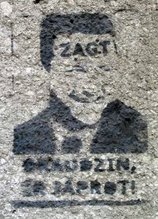I should have put up these links ealier, but anyway. . .I have added a new links section called "Folk Culture Corner." So far there are only three. . .I will add more later. These are links to groups of my own homeboys and gals in Minneapolis, where there is a very active community of people dedicated to folk culture performance. Ethnic Dance Theatre is a professional ensemble composed of a dance troupe and orchestra, and which collaborates closely with the Mila Vocal Ensemble. Mila used to be the Ethnic Dance Theater Choir before they became their own entity in order to pursue a very active perfomance schedule of their own.
I have performed as a dancer off and on with EDT for the better part of 6 years (for 4 years solidly, then off and on for the last 2 1/2), and if you are around the Minneapolis area this winter, you will be able to spot me in EDT's folk-dance version of The Nutcracker. By-the-way, I left Ukraine last Th for Riga, and fly tomorrow back to Minneapolis to jump into a month of rehearsals for the show (they have been rehearsing for some time now. . .).
Skeptical about such a thing? A folk-dance version of the Nutcracker? Well, I can tell you this: It is one of the best things this company has ever produced. Think about it: The whole second half after the intermission is nothing but folk dances, and how much more interesting when they are presented as real folk dances by professional dancers and musicians dedicated to authenticity, and not as character ballet (my biases being made obvious here, as usual. . .)?
Also, the setting for the whole story works well for a folk dance troupe: The first half in the EDT version is set in a Franconian (German) bourgeois's home, during which the guests perform a Franconian contra dance from the late 18th century (a dance which is from the EDT repetoire; all the dances in the show are from the company's repetoire). Drosselmeier is returning from Transylvania with a Hungarian Nutcracker doll, and the show ends with a big and rather stunning Hungarian, boot-slappin' and turning, dance (there is also a Hungarian solo thrown-in in the dream sequence as the Nutcracker comes to life . . .).
The fight scene is between Cossacks and Caucasians (North Ossetians, to be exact. . .), who during the fight, dance in the styllistically appropriate manner. Perhaps this all-too-much reproduces traditional antagonisms that should not be reproduced, but EDT's mission is:
"To foster understanding and awareness of world cultures through the re-creation and presentation of traditional ethnic dance and music. In a society where racial tensions are prevalent, we believe it is vital to promote and project the inherent beauty, dignity, and integrity of all peoples. We believe that ethnic music and dance are true affirmations of human artistic expression. Many of the cultures which are represented in our programs are currently in great conflict. Through our performances, we acknowledge the inherent beauty and dignity of all peoples."
EDT has long been very successful at working toward its mission or promoting cross-cultural understanding. For example, just after 911 the company produced a show called "The Silk Road," which was its way of combating the rising tide of anti-Muslim feeling in the US; it also has done an all-Balkan show in times during which the Balkans are looked upon as a savage, barely-European backwater. . .
Well, anyway, back to the Nutcracker, the Snow Queen sequence is set to a very enchanting Russian choral arrangment, after which EDT gets to perform in the second half one of its own Chinese pieces and an Arabic piece, etc.
EDT, as well as Mila, and also the folk orchestra OBI (Orkestar bez Ime, from the Bulgarian) linked in the section, are dedicated to making their performances as authentic as possible. The director of EDT for the last 31 or so years has spent the same amount of time traveling to and fro Eastern Europe to study, as have a number of the other dancers, musicians, and singers in each of these outfits, many of whom have also studied in other parts of the world, such as Central Asia and the Middle East. All three groups are linked to each other by way of sharing performers and ideas and interests. And OBI, as a folk orchestra, bucks the trend of so many folksy, eastern-Europeany groups in the US: that is, they aren't some kind of goofy, hip or hippy-ish, fusion of various Eastern European styles with American rock and rockabilly. They actually care to play in idiomatically correct ways, study with native players, and strive to be as much like the real wedding bands that play in Eastern Europe and elsewhere as possible. This is also true of EDT and Mila, whose members also train with native directors, and who over the years have had native performers join their ranks, either as guests at concerts or full fledged members of the company, and also have had trained members of various diasporas in Minneapolis joining their ranks (for example, from the Latvian and Ukrainian diaspora, hence my daughter!).
So check out the sites. See a show when you can: EDT mostly performs in Minneapolis and at festivals in Europe, while Mila and OBI can be found wandering about the US. Mila also is becoming a frequent guest on Garrison Keilor's Prairie Home Companion show.
You can find samples of the EDT orchestra's, Mila's, and OBI's music on the sites.
And one other thing: what a joy it was for me that this time in Ukraine, I finally began making some contacts with the community of people dedicated to authenticity. . .to village-based authenticity, that is. . .
Music and dance are my first, and perhaps only true, passions. . .
Subscribe to:
Post Comments (Atom)






No comments:
Post a Comment